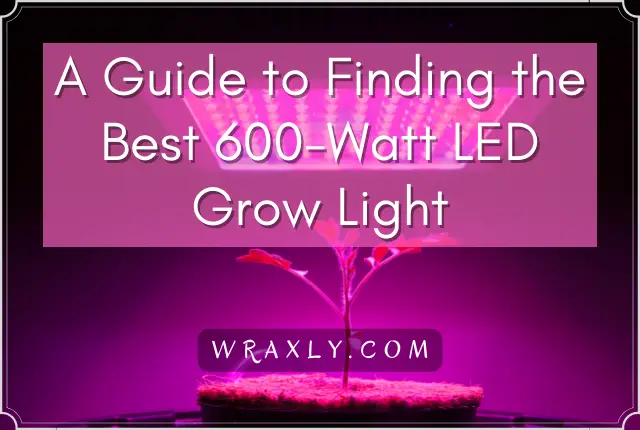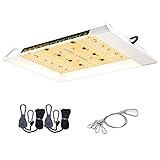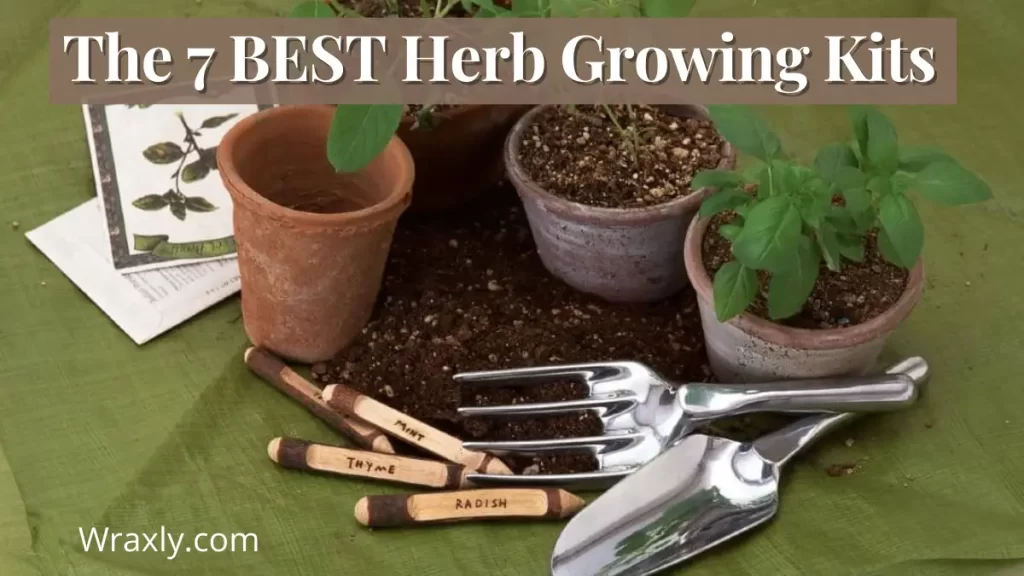Grow lights come in many different styles and finding the best one for you can be more challenging than you might first expect. As is the case, any time you buy a new piece of gardening equipment, you need to make sure you know what to look for before you make a purchase. And when it comes to deciding between the best 600-watt led grow lights, you’ll soon see that there is a lot you need to consider.
This article will serve you well as you make your next grow light purchase. Not only will we show you a few of the best 600-watt led grow light products, but we’ll also give you some general insights you must keep in mind any time you want to buy a grow light. But before covering those topics, we should begin by addressing a few top-level reasons why you should opt for an LED grow light in the first place.

What Are the Advantages of LED Grow Lights?
Light-emitting diode (LED) bulbs are not the only type of bulb that manufacturers include in their grow lights. Fluorescent, incandescent, and high-pressure sodium (HPS light bulbs) are some of the other popular grow light bulb options you’ll find. However, high quality LED grow lights often stand out from these other options by holding a few distinct advantages, including:
- Greater energy efficiency
- Less heat output during operation
- Excellent simulation of the sunlight spectrum
It’s often true that grow lights that use LED light will be somewhat more expensive than grow lights that use other bulbs. However, this is not always the case, and even if an LED grow light does prove to be more expensive, the benefits in the list are often worth the higher initial cost.
Based on those excellent capabilities and more, LED grow lights are only growing in popularity. As technology improves in this area, it’s safe to expect that LED grow lights will continue to improve in quality and performance as well. As such, LED grow lights are a fantastic option for most gardeners, and the products in the section below all qualify as some of the best 600-watt LED grow lights around.
The 5 Best 600-Watt LED Grow Lights Available for Purchase
You’ll find that grow light bulbs can come with one of many different watts of power. But we’ve limited our list to products that specifically include 600-watt LED bulbs. If that light intensity output is right for your indoor plants, then these products are some of the best brands available and will be a good option and will do a great job:
- TOAD LED Grow Lights 600W
- TYAGMAM Super Bright Grow Light
- MARS HYDRO TS 600W LED Grow Light
- Phlizon 2022 Upgraded 600W LED Plant Grow Light
- INDOSUN 600W LED Grow Light
While those products share the similarity of having 600-watt bulbs, there are other characteristics that make them vastly different from one another. Read on to find a description of each one and the overall pros and cons of each of these grow lights.
IN A HURRY? HERE’S OUR TOP CHOICES FOR BEST 600-WATT LED GROW LIGHTS
| Image | Title | Prime | Buy |
|---|---|---|---|
 | TOAD LED Grow Lights 600W, Dual Switch Full Spectrum Daisy Chain Function, Sunglasses, (Dual Chips 10W LEDs 60Pcs) | PrimeEligible | Check Price on Amazon |
 | Grow Light, 2ft T8,100W(4 x 25W, 600W Equivalent), Super Bright, Full Spectrum Sunlight Plant Light, LED | PrimeEligible | Check Price on Amazon |
Top | MARS HYDRO TS 600W LED Grow Light 2x2ft Coverage, New Diodes Layout Full Spectrum Grow Lamp | PrimeEligible | Check Price on Amazon |
 | Phlizon 2022 Upgraded 600W LED Plant Grow Light with Samsung LEDs Full Spectrum (600W) | PrimeEligible | Check Price on Amazon |
 | INDOSUN 600W LED Grow Light, Remote Control Dimmable Grow Lamps, 24H Auto On/Off Cycle Timing, Full Spectrum LED | PrimeEligible | Check Price on Amazon |
TOAD LED Grow Lights 600W
Our top pick is the TOAD LED Grow Lights 600W. It is a great price, which makes it an ideal option for those who want to save money. In addition to an affordable initial price compared to most of its competition, it also has admirable energy-saving capabilities. This ensures it won’t be too hard on the pocketbook to keep this grow light running.
The TOAD LED Grow Lights 600W is quite a reliable model with quality lights that will last for many years. In fact, the service life of this product can surpass a total of 110,000 hours. With multiple light modes, you can be confident that your light is giving an efficient output during that long service life. You also enjoy how easy it is to set up and start using this grow light as well. This will be the right choice for many gardeners.
Pros
- Affordable price
- Multiple light modes allow for energy savings
- Typically has an incredibly long service life
- Tends to be easy to install
Cons
- Lights can malfunction
- Plant growth is not always as vigorous as the manufacturer promises
- 🌺【 High Brightness & High Yields】: Compare with the traditional grow lamps,LED grow lights for indoor plants uses a high-tech dual chip SMD led Technology,service Life is more than 110000 hours, it can increase the light by 35%.adopts dual-chip LEDs (10W) to improve PAR value, brighter and efficient, but consuming only 85 watts.
- 🌺【High Energy Saving & 3 Lighting Modes】Grow lights for indoor plants Veg and Blooms buttons have different functions. Veg switch: Its blue led and white led. For seeding or young vegetative growth, you can use “Veg” switch only. Bloom switch: Its red led and white led. for flowering/blooming, you can use both “Veg” and “Bloom” switches at the same time. You can also use both “Veg & Bloom” to get more Red/Blue heavy output and deliver maximum performance for flowering and fruiting.
- 🌺【Full Spectrum for All Stages of Growth】led grow lights full spectrum 380nm to 780nm has done a lot of experiments to provide plants with a more matched spectrum. Including 3000K, 6000K, 470nm, 630nm, 660nm, 740nm and 730nm, provides plants in all stages from veg to flower with everything they need in the natural sunlight. IR chips can promote plant growth and defend insects and disease, blue and red LEDs are the essential light.
- 🌺【Daisy Chain & Efficient cooling system】Led grow lights full spectrum has Multiple high-speed mute fans,upgraded aluminum radiators and high thermal conductivity iron housing,enable the light bulbs to work at 40°F to 60°F which is lower than other lamps. In suitable temperatures, your plants will be well protected which could increase your lighting time and promote plant growth.Daisy-chain capabilities, no more than 5 lamps can be connected.
- 🌺【Widely used & Professional service】3 years Professional Service and free return for 90 days. Easy to Install.Ideal for indoor plants like orchid, pepper, potato, lettuce, chili, tomato living in sunless places like a greenhouse, indoor garden, vertical farm, grow tent. Led grow light full spectrum provides coverage area for a minimum of 2 X 2ft and the maximum coverage area of 4 X 4ft.
Prices pulled from the Amazon Product Advertising API on:
Product prices and availability are accurate as of the date/time indicated and are subject to change. Any price and availability information displayed on [relevant Amazon Site(s), as applicable] at the time of purchase will apply to the purchase of this product.
TYAGMAM Super Bright Grow Light
With the TYAGMAM Super Bright Grow Light, you get a grow light that is both lightweight and gives off a pleasing light that is easy on the eyes. Unlike many other grow lights, which prioritize light output at all costs, the light that comes from this model is a soft and white light. This prevents eye strain while your plants receive the light they need.
This model has a high rating, and includes a daisy chain feature where you can connect multiple pieces to harness the entire 600-watt output. Alternatively, you can choose to use just a few of the pieces to light a smaller growing area. Regardless of which route you choose, the TYAGMAM Super Bright Grow Light is easy to install. And if you run into any issues, you can always rely on the customer support team to find the help you need.
Pros
- Lightweight design
- Gives off a light that does not strain the eyes
- Reliable customer support team
- Possibility of linking multiple lights
Cons
- Light spectrum could improve
- Does not come with a comprehensive owner’s manual
- Full Spectrum - LED grow lights 2ft provide indoor plants with full-spectrum sunlight replacement. It provides the most reasonable grow light wave based on the ratio of the absorption of the plants
- Super Bright and Hight PPFD - Consuming only 100W , replace 600w general plant lights. Over 95% light energy can be absorbed by plants. The light efficiency can be increased by 20% with reflector. The shell of our light was made of 100% aluminum which provides the high-efficiency heat dissipation. Ensuring the longer service life of the led chips
- Easy Installation - With included clips and cable ties, you could install the lights by yourself in minutes. Plug and play, and you could link up to 8 lights in a series, saving your installation cost and time
- Eyes Protection - This grow light are suitable for planting plants in any indoor application. Sunlight white color temperature makes your eyes feel comfortable. It works extremely well for your plant grow tents, plant grow shelves, seedling cultivation, succulents, hydroponic rooms, greenhouses, etc.
- Brand Protection - TYAGMAM has been filed for registration with the U.S. Trademark Office. If you have any questions, Please send us an email and we will contact you within 24 hours. We will provide a replacement or refund based on your preferenc
Prices pulled from the Amazon Product Advertising API on:
Product prices and availability are accurate as of the date/time indicated and are subject to change. Any price and availability information displayed on [relevant Amazon Site(s), as applicable] at the time of purchase will apply to the purchase of this product.
MARS HYDRO TS 600W LED Grow Light
Many grow lights strive to meet the perfect balance of durability and a lightweight design, but few can pull it off. The MARS HYDRO TS 600W LED Grow Light manages to strike this balance well while providing an intense light output that leads to even more impressive plant growth. With this light, you can expect to see higher yields and more vigorous plant growth overall.
Part of what makes this model so effective is that its design does not allow too much light loss. Instead, nearly all the light this product gives off will reach your plants, allowing them to grow as effortlessly as possible. Conveniently, the MARS HYDRO TS 600W LED Grow Light is also quiet during operation. This means that you won’t have to listen to an annoying hum while your light is shining. The MARS HYDRO TS is an excellent choice for any beginner gardener.
Pros
- Durable design while remaining lightweight
- Makes for impressively efficient and healthy plant growth
- The design allows for minimal light loss
- Remains incredibly quiet during operation
Cons
- Electrical issues can arise during use
- Can overheat more often than you would like
- SUNLIGHT FULL SPECTRUM GROW LIGHT, Infinite close to natural sun light, full spectrum 3000K 5000K and IR 660nm 760nm RED, suit for all plants whole stages indoor growing, rapid plant response from seed to flower
- HIGH EFFICIENCY ENERGY SAVING PLANT LIGHT, Consuming only 100 Watts true output with 225 PCS LEDs, more scientifically and energy-efficient! Perfect for 2 x 2 veg stage, 1.5 x 1.5 bloom stage, higher intensity in a MARS HYDRO grow tent, reflective area, or by crossing over using multiple TS600
- ACHIEVE ENVIOUSLY LARGE HARVESTS with LED LIGHTING: High-performance gardens with new LED technology provide highest PAR/LUMEN output(430μmol/m².s), Max 2.0g yield per wattage (power draw), achieve maximum quality and quantity, much better than traditional 150w HPS grow systems
- HIGH REFLECTIVE HEAT SINK LED GROW SYSTEM, quickly heat dispersing material aluminum reducing light lost to aisles and walls, increase the light intensity up to 20%, allowing your plants receive more energy and without burning your plants for maximum headroom
- NOISE-FREE FANLESS LED GROW LAMPS FOR INDOOR PLANTS, Designed for home growers, fans get noisy when long time use, but this LED light board use aluminum make it cooling down instead use fans, bring you a FANLESS QUIET grow experie
Prices pulled from the Amazon Product Advertising API on:
Product prices and availability are accurate as of the date/time indicated and are subject to change. Any price and availability information displayed on [relevant Amazon Site(s), as applicable] at the time of purchase will apply to the purchase of this product.
Phlizon 2022 Upgraded 600W LED Plant Grow Light
Anyone with the goal of encouraging the best flower development in their indoor grow room will want to check out the Phlizon 2022 Upgraded 600W LED Plant Grow Light. This grow light has the ideal light spectrum to promote copious flowering and proves to have great longevity, too.
The Phlizon 2022 Upgraded 600W LED Plant Grow Light is also a versatile grow light as you can set it up in a growing room, or you can incorporate it into a small grow tent. What makes this model even more of a crowd-pleaser is its ease of use. Whether you are a complete novice or a professional grower, you’ll have no problem getting the most out of the high-quality grow light.
Pros
- Helps promote great flowering
- Reliable for continued long-term use
- Works well in a grow room or a grow tent
- Relatively easy to use, even for beginners
Cons
- The built-in fan can be a bit loud
- Can take up a significant amount of space compared to similar models
- NO REFLECTOR NO DANGER- Many others grow lights are used led spotlight reflector to make the light look beautiful, but we dont use it because the led reflector is not heat-resistant. If a short circuit occurs,reflector at 80℃ is easy to melt and fire. we do not use the reflector, we can not give up the safety beause of beauty.
- COMPARE TO HPS/MH- Compared to MH / HPS lamps, it generates less heat, more energy saving and lower electricity bills and more comprehensive light spectrum. The 600W LED grow light can replace 100watt HPS/MH. More effective coverage area than any reflector series lights. Perfect fit for a 2x2ft growing area at 24 height. The difference of us is that we use double cooling fans. which can most extend the light life.
- DOUBLE SWITCH- Veg and Bloom button have different function. Veg switch: Its blue led and white led. For seedling or young vegetative growth,you can use Veg switch only. Bloom switch: Its red led and white led. For flowering/blooming,you can use both Veg and Bloom switches together. View Angle of LEDs: 90°and 120°
- FULL SPECTRUM- We did lots of experiments to ensure that this full spectrum promotes plant growth. It includes universal blue red IR UV and white leds which can provide everything plant desired in the natural sunlight. The IR and UV leds can promote plants to defense mechanisms, blue and red led is essential light for plant growth.
- BEST SERVICE- Phlizon is a professional LED light manufacturer with strong R&D team and many light tester. 2 years warranty plus 30 days money back guarantee. If you have any problems, please dont hesitate to contact us. We will provide you with a completely satisfing rep
Prices pulled from the Amazon Product Advertising API on:
Product prices and availability are accurate as of the date/time indicated and are subject to change. Any price and availability information displayed on [relevant Amazon Site(s), as applicable] at the time of purchase will apply to the purchase of this product.
INDOSUN 600W LED Grow Light
The INDOSUN 600W LED Grow Light is a grow light that may give you greater control than any other model on the market. This light includes a dimmer that gives you direct control over the immediate light output. It also includes a remote control that makes it easy to program your light from a distance.
The INDOSUN 600W LED Grow Light includes multiple timer setting options, giving you the ability to schedule the light output in advance, based on what your plant’s specific needs are. Another great aspect of the INDOSUN 600W LED Grow Light is that it stays cool during use, while other products often overheat on a more frequent basis.
Pros
- Dimmable, giving you great control over light output
- Includes a remote control
- Multiple automated timer setting options
- Stays cool while in use
Cons
- Not the brightest grow light on the market
- Some components could be of better quality
What to Look for in a Grow Light
If none of the products in our list above have caught your eye, you’ll need to explore your options elsewhere. As you do, it helps immensely to know the general factors that make for a high-performance LED grow light. The sections to follow will help you do just that.
Energy Efficiency
Consider the fact that most indoor growers will need to run their grow lights for a large portion of the day if they want the best results for their plants. At times, your plants may call for you to keep these lights on for more than 15 hours in a single day. Such prolonged uses make energy efficiency and power consumption the top concerns when picking a grow light.
While LED lights tend to have better energy efficiency than other bulbs, you’ll see that there remain energy use discrepancies between individual LED grow light models. At first glance, these differences can seem minimal. However, choosing a grow light with better energy efficiency can result in surprisingly significant energy savings in the long run.
At times, you might feel the urge to choose a less energy-efficient model, as these lights usually come with a lower initial cost. But in many cases, lights with greater energy efficiency often prove to be the more economical choice in the long term despite costing more to begin with.
Cool Operation
Overheating can be a problem for grow lights, and it is no surprise to see why. While you run your lights for hours on end, it is easy to see how the continued light output can create intense heat build-up in the entire system.
Some grow lights are specifically designed to prevent a lot of heat from building up. As we mentioned earlier, grow lights that use LEDs are often cooler in general. But the overall design of a grow light can contribute to its operating temperature as well.
At times, a grow light that overheats will even be hot to the touch while they are on. By contrast, the best grow lights on the market show an impressive ability to remain cool while working as effectively as their competitors.
Lifespan and Longevity
This category could apply to nearly any garden product and is equally important when selecting a grow light. The quality of the materials that comprise your light and the integrity of the construction process that assembled them are two of the most important factors in how long your lights last.
Grow lights with an alluringly low cost can come with some shoddy materials and components. These pieces won’t last so we always recommend going with a grow light from a reputable manufacturer.
Before settling on a grow light to purchase, take time to research its listed materials and the manufacturer’s reputation for creating high-quality products. If both those factors checkout, then the light in question will likely serve you well for a long time.
Light Spectrum
The idea behind a grow light is to mimic the light that a plant would receive from the sunlight if it were growing outdoors. Interestingly, you can use just any light to recreate this effect. The sun’s rays come in a specific spectrum range, which grow lights attempt to recreate.
Some grow lights are better than others at recreating the quality of light that allows plants to photosynthesize. The best of these lights often advertise themselves as being full-spectrum. Full-spectrum lights do a surprisingly good job of matching the quality of light the sun produces naturally while supporting plants throughout each of their growth phases.
Light spectrums are a somewhat complex topic, but it is one that you should be aware of if you are in the market for a new grow light. Thankfully, the top manufacturers will list the light spectrums their light produces so that you can make a clear comparison between products.
Grow Space Coverage
One factor that many people fail to recognize while purchasing their first grow light is growth space coverage. Simply put, each grow light will be capable of providing light to a different sized coverage area. The area of coverage is related to the wattage of the light in question.
Generally, a good rule of thumb is that around 30 watts of light output will allow for about one square foot of growing space. It’s your job to match the wattage of your light to the amount square feet your plants take up. With too little wattage, your plants won’t get all the light they need, while too much wattage is energy waste.
Take time to consider the plants you hope to grow and to anticipate their mature canopy size. Understanding these dimensions will be crucial as you choose the ideal wattage for your grow lights.
Special Features and Programming
The best 600-watt LED grow lights on the market today do much more than turn on and off. Instead, these models come with a whole host of special features that allow you to customize your grow light experience.
For example, many grow lights come with remote controls that include dimmers that let you change the light output instantly. Other grow lights will include multiple light modes, each of which may offer a different quantity or quality of light. Still other LED grow lights will be programable, meaning you can set up automatic lighting cycles. This way your lights will turn on and off and change intensity based on the schedule you set.
Look for these special features as you shop for a grow light. You may be amazed by what some of these lights can do. With the right set of unique characteristics, you’ll stand a better chance of tailoring your grow lights to the plants you own and their specific light needs.
Plant Compatibility
This final point about choosing a grow light may be one of the most important. Since grow lights come in many different styles, some are better suited to serving certain types of plants than others.
Likewise, some grow lights will be better capable of promoting foliage development, flowering stage, or fruit production. These lights often include a spectrum that makes them more applicable to each of those stages.
It is possible to find grow lights that will work for most of the plants that people commonly grow indoors. However, for the best results, you should take into consideration the types of plants you intend to grow. Matching your grow light to the distinct life cycle that each of your plant species enjoys is the surest way to guarantee that your indoor gardening efforts will be successful.
You may also be interested in… Using Grow Bags for Growing Your Own Killer Bud
Common Questions about Using LED Grow Lights
If using LED grow lights is a new venture for you, then you likely have a few questions. Below you will find a few of the most common questions people ask and some answers for each one.
The cost of running an LED grow light will vary depending on several factors, including the wattage of the bulbs, how many fixtures you have, how long you run them, and more. Since so many of these cost influences are at play, you can expect the monthly price of running a grow light to vary greatly. However, in many cases, an LED grow light will cost ten dollars or more to use per month.
At first, it appears that LED lights and LED grow lights are essentially the same thing. However, this is not at all the case. While standard LED bulbs can emit light, they do not emit the full spectrum light that plants need to grow. Conversely, LED grow lights do include a broader spectrum, making them suitable for facilitating plant growth.
At times, it is possible for an LED grow light to burn your plants. This problem mainly occurs as the result of one or two common causes. The first potential cause is that your grow lights are simply too close to the plants they serve. Elevating your grow light by a few inches will allow for heat dissipation and prevent your plants from burning. Alternatively, the lights may be overheating, which can cause burning as well. Both issues can singe your plant’s leaves or cause a phenomenon called photo-bleaching.
The length of time for which you keep your LED grow lights on will depend on what kind of plants you intend to grow. Some plants will call for several hours of light exposure, while others may need significantly more. Generally, you can assume that you’ll need to keep your grow lights on for at least eight hours each day. However, you may find you need to keep them on much longer than that.
While many plants call for a high volume of light exposure each day, that does not mean you should run your lights indefinitely. Specifically, it is best to have your grow lights off for at least some portion of the night. Plants enjoy periods of darkness, as they allow the plant to conduct critical metabolic processes that keep it alive and thriving.
Final Thoughts on Finding the Best 600-Watt LED Grow Light
Finding the best 600-watt LED grow light is not always that easy. But we hope that the guidance in the article above will set you on the right track. With knowledge of the best products in this category and some ideas about what makes a great LED grow light, you’re more than ready to choose the best model for your grow room.

John Haryasz is a freelance writer and landscape designer. In the field of landscape architecture, he has contributed to many successful design projects throughout the country. As a writer, John specializes in creating captivating and informative web content. Through that work, he aims to share his design knowledge and promote engagement with the outdoor world.







